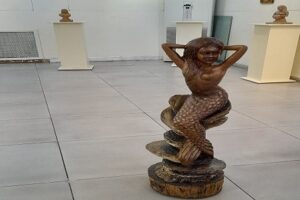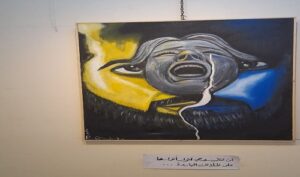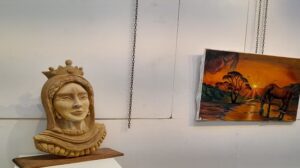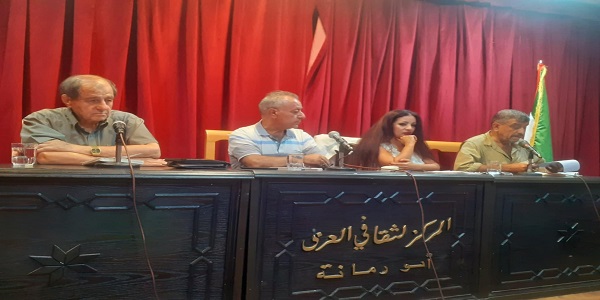 The Directorate of Culture in Damascus held an event entitled “Fragments of the Soul” at Abou Rumaneh Cultural Center in Damascus .
The Directorate of Culture in Damascus held an event entitled “Fragments of the Soul” at Abou Rumaneh Cultural Center in Damascus .
The event included an art exhibition in addition to a critical reading of the novel “The Fall of the Last Ember” by the visual artist and poet Rana Mahmoud, with the participation of Dr. Atef Boutros, journalist Ali Al-Ra’i, and writer Ayman Al-Hasan.
The exhibition displayed 22 acrylic paintings . The paintings were drawn on canvas and related to the expressionist school beside displaying 9 sculptures.
 About this event Artist and poet Rana Mahmoud told Syria times: “My paintings depict social and human topics. I painted the effects of war on the people including poverty, hunger and homelessness. Also, some of my paintings embodied the image of women in all her human states: loss, pain, sadness and motherhood.
About this event Artist and poet Rana Mahmoud told Syria times: “My paintings depict social and human topics. I painted the effects of war on the people including poverty, hunger and homelessness. Also, some of my paintings embodied the image of women in all her human states: loss, pain, sadness and motherhood.
My sculptures also embodied women like the mermaid, the poet, the queen, and others, in which I used a variety of techniques such as artificial stone and wood” She said.
 “In my drawing, I used acrylic colors on canvas and with each painting I chose several verses from my poetry. I have five poetry collections and I added a piece of poetry to each painting because I am convinced that poetry is linked to art, and everyone sees the paintings in his/ her own way” Rana said.
“In my drawing, I used acrylic colors on canvas and with each painting I chose several verses from my poetry. I have five poetry collections and I added a piece of poetry to each painting because I am convinced that poetry is linked to art, and everyone sees the paintings in his/ her own way” Rana said.
“As for the novel “The Fall of the Last Ember” , the novel is about the journey of Ramah who is a plastic artist, from Latakia to Damascus. During her journey, she saw characters who talked about their social circumstances and their suffering during the war in Syria. Through my novel, I wanted to shed light on the negative effects of war through the characters in my novel”. Rana Mahmoud concluded.
In his turn journalist and critic Ali Al- Ra’i said that Rana Mahmoud wrote poetry, and she has five poetry collections, in addition to drawing with words, she makes sculptures.
 For the first time she wrote the novel “The Fall of the Last Ember” which is published by Tutul Publishing House in Damascus, a novel from the novels of the Syrian war with a cohesive structure distinguished by multiple techniques.
For the first time she wrote the novel “The Fall of the Last Ember” which is published by Tutul Publishing House in Damascus, a novel from the novels of the Syrian war with a cohesive structure distinguished by multiple techniques.
Interviewed and Photos: Nada Haj Khidr



